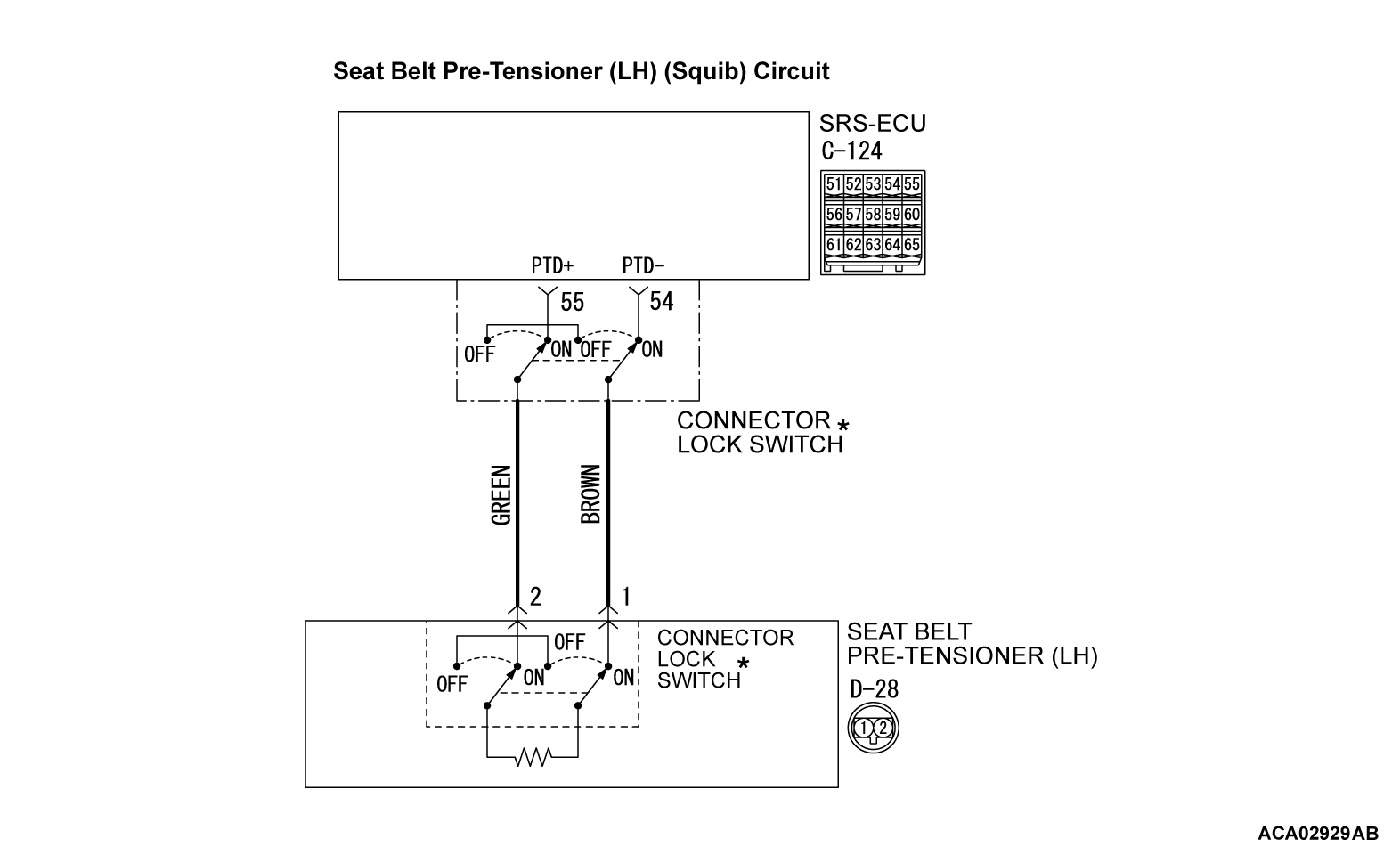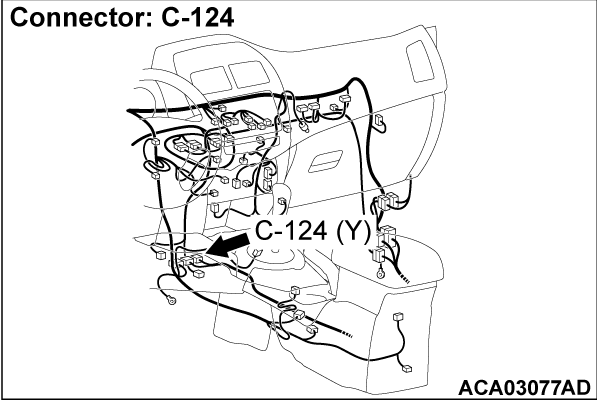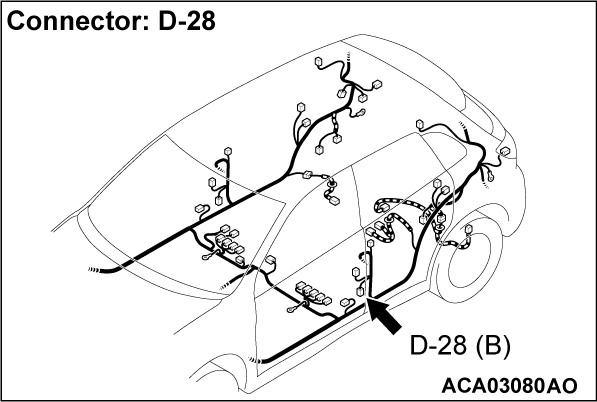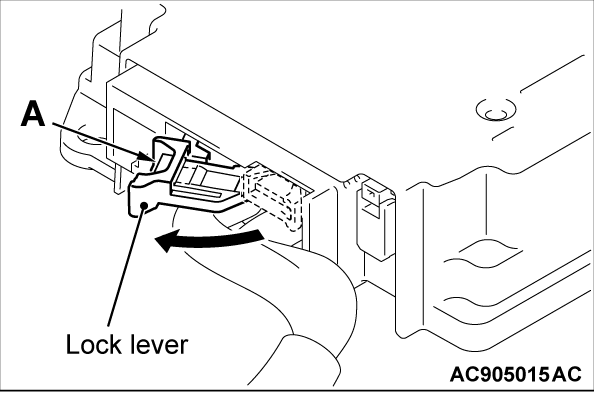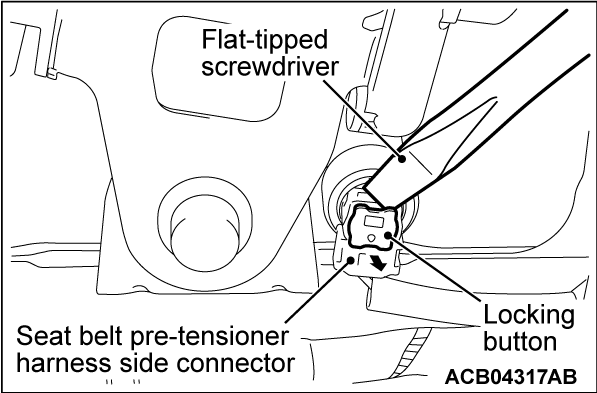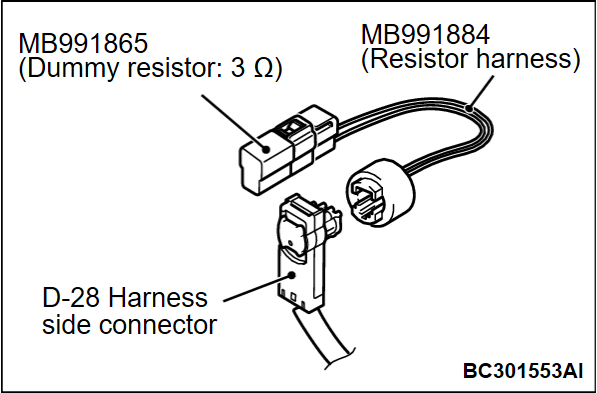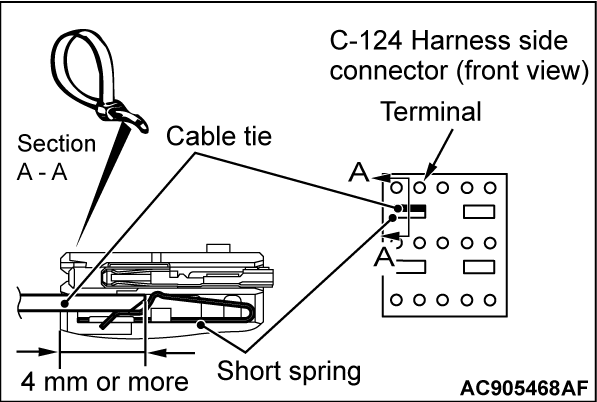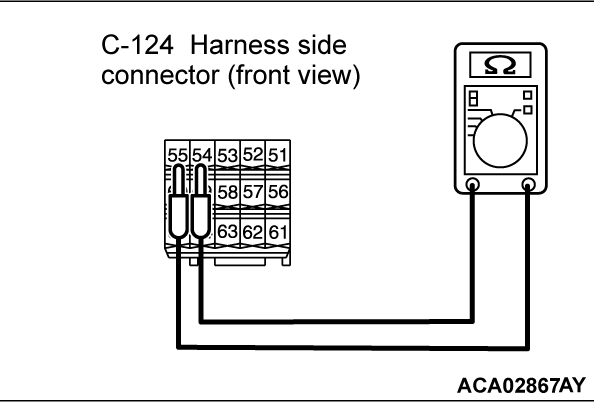DTC B1603: Driver's Seat belt Pre-tensioner (Squib) System (Short Circuit Between Squib Circuit Terminals)
| caution | If DTC B1603 is stored in the SRS-ECU, always diagnose the CAN main bus line. |
CIRCUIT OPERATION
The SRS-ECU judges how severe a collision is by detecting signals from the front impact sensors and the front air bag analog G-sensor. If the impact is over a predetermined level, the SRS-ECU sends an ignition signal. At this time, if the front air bag safing G-sensor is on, the pre-tensioner will deploy.
DTC SET CONDITIONS
This DTC is stored if there is abnormal resistance between the input terminals of the driver's side seat belt pre-tensioner (squib).
TROUBLESHOOTING HITS
- Improper engaged connector or defective short spring*
- Short circuit between the driver's seat belt pre-tensioner (squib) circuit terminals
- Damaged connector(s)
- Malfunction of the SRS-ECU
DIAGNOSIS
STEP 1. Using scan tool MB991958, diagnose the CAN bus line.
(1)
| caution | To prevent damage to scan tool MB991958, always turn the ignition switch to the "LOCK" (OFF) position before connecting or disconnecting scan tool MB991958. |
(2) Turn the ignition switch to the "ON" position.
(3) Diagnose the CAN bus line.
(4) Turn the ignition switch to the "LOCK" (OFF) position.
Is the CAN bus line found to be normal?
STEP 2. Recheck for diagnostic trouble code.
Check again if the DTC is stored.
(1) Erase the DTC.
(2) Turn the ignition switch to "ON" position.
(3) Check if the DTC is stored.
(4) Turn the ignition switch to the "LOCK" (OFF) position.
Is the DTC stored?
STEP 3. Check SRS-ECU connector C-124 and driver’s seat belt pre-tensioner connector D-28.
(1) Disconnect the negative battery terminal.
(2) While pushing the part "A" indicated in the figure of the harness side connector, turn the lock lever to the direction of the arrow to release the lock lever. After disconnecting the C-124 SRS-ECU connector, connect it again.
(3) Disconnect D-28 driver's seat belt pre-tensioner harness side connector, and then reconnect it. Use a flat-tipped screwdriver to pull out the connector locking button toward the arrow direction, release the lock, and then disconnect the connector.
(4) Connector the negative battery terminal.
(5) Erase the diagnostic trouble code memory, and check the diagnostic trouble code.
Is DTC B1603 stored?
 The procedure is complete. It is assumed that DTC B1603 stored because connector C-124 or D-28 was engaged improperly.
The procedure is complete. It is assumed that DTC B1603 stored because connector C-124 or D-28 was engaged improperly.STEP 4. Check the driver's seat belt pre-tensioner.
(1) Disconnect the negative battery terminal.
(2) While pushing the part "A" indicated in the figure of the harness side connector, turn the lock lever to the direction of the arrow to release the lock lever. After disconnecting the C-124 SRS-ECU connector, connect it again.
(3) Disconnect driver's seat belt pre-tensioner connector D-28. Use a flat-tipped screwdriver to unlock the locking button at the harness side connector by withdrawing it toward you in two stages, and then disconnect the connector.
(4) Connect special tool MB991865 to special tool MB991884.
(5) Connect special tool MB991884 to the D-28 harness side connector.
(6) Connect the negative battery terminal.
(7) Erase diagnostic trouble code memory, and then check the diagnostic trouble code.
Is DTC B1603 stored?
STEP 5. Check the driver’s seat belt pre-tensioner circuit. Measure the resistance at the SRS-ECU connector C-124.
(1) Disconnect the negative battery terminal.
(2) While pushing the part "A" indicated in the figure of the harness side connector, turn the lock lever to the direction of the arrow to release the lock lever, and disconnect the C-124 SRS-ECU connector.
(3)
Disconnect driver's seat belt pre-tensioner connector D-28. Use a flat-tipped screwdriver to unlock the locking button at the harness side connector by withdrawing it toward you in two stages, and then disconnect the connector.
| danger | To prevent the seat belt pre-tensioner from deploying unintentionally, disconnect the driver’s seat belt pre-tensioner connector D-28 to short the squib circuit. |
(4)
| caution | Insert an insulator such as a cable tie to a depth of 4mm (0.16 inch) or more, otherwise the short spring will not be released. |
Insert a cable tie [3 mm (0.12 inch) wide, 0.5 mm (0.02 inch) thick] between terminals 54, 55 and the short spring to release the short spring.
(5) Check for continuity between C-124 harness side connector terminals 54 and 55.It should be an open circuit.
Is it open circuit?
STEP 6. Check the harness for short circuit between SRS-ECU connector C-124 (terminal No.54 and 55) and driver’s seat belt pre-tensioner connector D-28 (terminal No.1 and 2).
Is the check result normal?
![[Previous]](../../../buttons/fprev.png)
![[Next]](../../../buttons/fnext.png)
